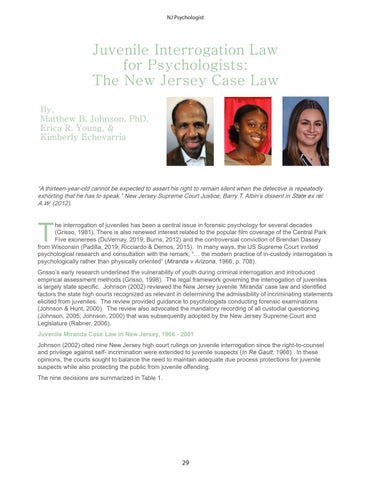NJ Psychologist
Juvenile Interrogation Law for Psychologists: The New Jersey Case Law By, Matthew B. Johnson, PhD, Erica R. Young, & Kimberly Echevarria
“A thirteen-year-old cannot be expected to assert his right to remain silent when the detective is repeatedly exhorting that he has to speak.” New Jersey Supreme Court Justice, Barry T. Albin’s dissent in State ex rel. A.W. (2012).
T
he interrogation of juveniles has been a central issue in forensic psychology for several decades (Grisso, 1981). There is also renewed interest related to the popular film coverage of the Central Park Five exonerees (DuVernay, 2019; Burns, 2012) and the controversial conviction of Brendan Dassey from Wisconsin (Padilla, 2019; Ricciardo & Demos, 2015). In many ways, the US Supreme Court invited psychological research and consultation with the remark, “… the modern practice of in-custody interrogation is psychologically rather than physically oriented” (Miranda v Arizona, 1966, p. 708). Grisso’s early research underlined the vulnerability of youth during criminal interrogation and introduced empirical assessment methods (Grisso, 1998). The legal framework governing the interrogation of juveniles is largely state specific. Johnson (2002) reviewed the New Jersey juvenile ‘Miranda’ case law and identified factors the state high courts recognized as relevant in determining the admissibility of incriminating statements elicited from juveniles. The review provided guidance to psychologists conducting forensic examinations (Johnson & Hunt, 2000). The review also advocated the mandatory recording of all custodial questioning (Johnson, 2005; Johnson, 2000) that was subsequently adopted by the New Jersey Supreme Court and Legislature (Rabner, 2006). Juvenile Miranda Case Law in New Jersey, 1966 - 2001 Johnson (2002) cited nine New Jersey high court rulings on juvenile interrogation since the right-to-counsel and privilege against self- incrimination were extended to juvenile suspects (In Re Gault, 1966). In these opinions, the courts sought to balance the need to maintain adequate due process protections for juvenile suspects while also protecting the public from juvenile offending. The nine decisions are summarized in Table 1.
29












